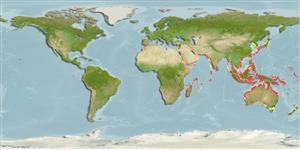Environment: milieu / climate zone / depth range / distribution range
экология
морской; пресноводный; солоноватоводный; пределы глубины 0 - ? m. Tropical
Indo-West Pacific: in western Pacific, known from Thailand, the East Indies, Borneo, and the Philippines north to China and Nagasaki, Japan, south to New Guinea and northern half of Australia.
Length at first maturity / Size / Вес / Возраст
Maturity: Lm ?, range 13 - ? cm
Max length : 31.2 cm SL самец/пол неопределен; (Ref. 9843)
колючие лучи спинного плавника (общее число) : 0; членистые (мягкие) лучи спинного плавника (общее число) : 14 - 17; колючие лучи анального плавника: 0; членистые (мягкие) лучи анального плавника: 13 - 17; позвонки: 51 - 56. Prolonged, beak-like lower jaw, shorter than head length, its length contained in 4.7-8.6 times in SL and 1.2-2.0 times in head length; upper jaw short, scaly, blunt and rounded, its width contained in 0.5-0.6 times in its length; preorbital bone 1.75-2.15 times in diameter of orbit and 0.9-1.15 times in length of upper jaw; preorbital ridge present; posterior branch to preorbital lateral line canal present. Total number of gill rakers on first arch 26-39; dorsal fin rays 14-17, usually 16; anal fin rays 13-17, usually 15 or 16. Caudal fin forked, with lower lobe longer than upper.
Inhabits more turbid and estuarine situations than does Hyporhamphus dussumieri and is not found in oceanic islands (Ref. 9843). May enter rivers (Ref. 559). Found in medium to large-sized rivers of the lower Mekong (Ref. 12975). Occurs in schools (Ref. 3132). Taken mostly with shore seines; marketed mostly fresh and dried salted (Ref. 9843).
Life cycle and mating behavior
Maturities | размножение | Spawnings | Egg(s) | Fecundities | личинки
Collette, B.B. and J. Su, 1986. The halfbeaks (Pisces, Beloniformes, Hemiramphidae) of the Far East. Proc. Acad. Nat. Sci. Philadelphia 138(1):250-301. (Ref. 10943)
Статус Красного Списка МСОП (Ref. 130435)
Угроза для людей
Harmless
Использование человеком
рыболовство: не имеет хозяйственного значения
дополнительная информация
инструменты
Специальные отчеты
Скачать в формате XML
ресурсы в Интернет
Estimates based on models
Preferred temperature (Ref.
123201): 24.1 - 29.3, mean 28.4 °C (based on 3099 cells).
Phylogenetic diversity index (Ref.
82804): PD
50 = 0.5000 [Uniqueness, from 0.5 = low to 2.0 = high].
Bayesian length-weight: a=0.00240 (0.00133 - 0.00433), b=3.08 (2.93 - 3.23), in cm total length, based on LWR estimates for this species & Genus-body shape (Ref.
93245).
Trophic level (Ref.
69278): 3.0 ±0.0 se; based on diet studies.
устойчивость к внешним воздействиям (Ref.
120179): высокий, минимальное время удвоения популяции до 15 месяцев (Preliminary K or Fecundity.).
Fishing Vulnerability (Ref.
59153): Low to moderate vulnerability (28 of 100).
